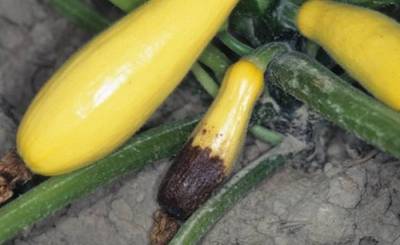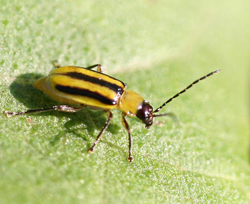Some Like It Hot — Cucumbers, Melons and Squash
By Janet Scheren, Fairfax Master Gardener
 Cucumbers, melons (such as cantaloupe), squash and watermelon have a lot in common. For starters they are all members of Cucurbitaceae family. While there are more than 800 cucurbit species, they break down into four major groups: cucumbers, melons (such as cantaloupe), squash (including pumpkins) and watermelons.
Cucumbers, melons (such as cantaloupe), squash and watermelon have a lot in common. For starters they are all members of Cucurbitaceae family. While there are more than 800 cucurbit species, they break down into four major groups: cucumbers, melons (such as cantaloupe), squash (including pumpkins) and watermelons.
These vining vegetables are full of vitamin A, but that’s not all they have in common: They grow best where the summer is hot, dry and sunny. Regions that fit this climate profile produce the fastest growing, most prolific and best flavored crops. Cloudy, rainy days actually stall their growth. Within this family, squash can endure cooler, wetter weather better than their cousins. If you’re just dipping your toe into growing Cucurbits, squash — both summer and winter varieties — are a good place to start. Cucumbers come next on the forgiveness scale, then cantaloupes. Watermelons are the most demanding of hot, dry conditions.
These needs come into play when locating cucurbits in your garden. Native Americans got it right when they planted squash on hills of dirt, particularly where drainage is a problem. This keeps the roots warmer and avoids direct watering that will cool off and stall the growth of these heat loving plants. If irrigation is needed to maintain adequate soil moisture, water at the edge of growing hills or beds rather than directly on or at the base of plants. And, of course, Cucurbits need lots of sun, so southern exposure is ideal.
Squash and cucumbers need rich, well drained soil with a consistent level of moisture and plenty of organic matter. Melons prefer loose, warm, sandy soil with added organic matter. Using trellises or cages offers two advantages: It not only lifts the plant off the ground providing better air circulation to prevent disease, but it also reduces their footprint in your garden by using vertical space rather than sprawling out.
Cucurbits’ need for hot, dry weather is also a tip-off to its disease risk. These plants are susceptible to powdery and downy mildew. Both diseases coat the leaves of plants and inhibit photosynthesis. They may survive this disease, but their fruit will likely have less flavor. Use drip irrigation to reduce leaf wetness and lower disease pressure. You’ll also want to allow plenty of room around the plants to help them dry off quickly after a rain.

Blossom end rot on yellow squash
Another condition to keep an eye out for is blossom end rot. This results in fruit that has begun to form, turning black on the end and rotting. While the issue is insufficient calcium being taken up by the plant, in most cases you’ll find inconsistent watering inhibits the uptake of calcium from the soil into the plant. Check your soil moisture and work to keep it consistent. If that still doesn’t correct the problem, you can add calcium to the soil. For a more immediate effect, crush calcium tablets into sufficient water and use this as a foliar spray on affected plants.
Cucurbits have two main pests: squash vine borer and cucumber beetles. Squash vine borers do what their name says. They bore into the stems where they lay their eggs. The hatching larvae damage the stems to the extent that vines down the line die. Some squash and pumpkins add additional tap roots along their vines, so fruit can continue to grow and develop even if the vine upstream is damaged. In our region, squash vine borers are generally gone by July 4, so one strategy is to plant a smaller early crop and a main crop of squash after that date. Floating row covers can also be used to deter this pest. This is a great way to produce lots of pumpkin and winter squash varieties that store well for harvest in the fall.

Striped cucumber beetle
Adult cucumber beetles as well as their larvae feed on Cucurbits. Adults will attack the tender young growth of stems and leaves as well as the buds and petals of mature specimens. In addition to chewing damage, they also spread disease, typically bacterial wilt and cucumber mosaic virus. The best method of control for cucumber beetles is weed management around the garden, as these pests overwinter in weeds around garden edges.
Cucurbits require pollination, so planting lots of flowers in or near the vegetable garden will help attract the insects needed to pollinate your squash blossoms. Most cucurbits have both male and female flowers; a rare few will self-pollinate. Male blossoms do not produce fruit. If you are frustrated with the amount of fruit your squash vine is producing, it may be that your plant is producing mostly male blossoms. You can tell the difference between male and female flowers because female flowers have a baby fruit attached between the stem and the flower. If the female blossom is not pollinated, the immature fruit and flower will shrivel up and fall off. If pollinated it will grow and eventually ripen.
Melons (cantaloupe) take between 70 to 140 days to reach maturity. Don’t let nighttime temperatures dip below 65 F. Varieties recommended for Virginia include Eden Gem, Kansas, and Erlidew. Each of these takes about 90 days to ripen.
Watermelons average 110 days from seeding to ripe fruit. Smaller varieties are a good choice for Virginia as they mature more quicky. A few recommended varieties include Sugar Baby (77 days), OrangeGlo (85 days), and Crimson Sweet (85 days).
Winter squash and pumpkins need between 80 to 100 days to mature. The Waltham Butternut squash is one of the most enduring classics. If cured properly in a hot dry place then stored in a cool, dark and dry space, it can last one full year and sometimes more. A more compact alternative is Cornell’s Bush Butternut, which is ready to harvest in 90 days. Delicata and Table Queen Acorn squash are also classic heirlooms worth growing. For pumpkins, consider growing Small Sugar or Cinderella.
Summer squash range between 50 to 65 days to mature, including pattypan, scalloped, yellow and zucchini. Varieties include Patty Pan and Yellow Crookneck. For zucchini, Black Beauty, Tender Gray and Butter Blossom are excellent selections.
Cucumbers require 55 to 65 days to reach maturity depending upon the variety. They can be sown or set out in soil as cool as 60 F. Burpless type cucumbers can be grown for eating as well as pickling. Some varieties recommended for our area are Marketmore 80, Poinsett 76, and Straight Eight. You may also enjoy trying Lemon, a round, yellow cucumber. These should be harvested small — a little larger than a golf ball.
Resources
• Home Grown Pantry by Barbara Pleasant
• Grow Great Virginia Vegetables by Ira Wallace
• Cucurbits, Lina Quesada-Ocampo, Extension Plant Pathology, North Carolina State Extension
• Virginia’s Home Garden Vegetable Planting Guide: Recommended Planting Dates and Amounts to
Plant, Virginia Cooperative Extension
• Cucurbits, Iowa State University Extension and Outreach